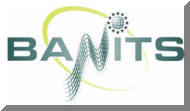Finished Project

BANITS
 BANITS received the Celtic Excellence Award on February 2008
BANITS received the Celtic Excellence Award on February 2008
Broadband Access Networks Integrated Telecommunication Systems
![]()
| Project Coordinator | Project Consortium | |
| Javier Hurtado Telefónica I+D Spain e-mail: hurtado (at) tid.es |
Telefónica I+D, ES | Inelcom, ES |
| Alcatel Bell, BE | Robotiker, ES | |
| K.U. Leuven R&D, BE | Ericsson, SE | |
| Optibase, IL | UpZide Labs, SE | |
| RAD Data Communications, IL | ||
This is a “Celtic” project;
| Project Key Information | ||||
|
Start date |
End date | Budget (total) | Effort (total) | Project-ID |
| January 2004 | March 2006 | 10.1 MEuro | 106.7 PY | CP1-032 |
| Abstract |
| BANITS aims to extend the knowledge in the area of the Access Network in order to deliver the new service packages to residential and business customers, among them multimedia high quality services, with special focus on maximum utilization of existing network infrastructure. Such new services are facilitated by the high growth rate of the xDSL/DSLAM infrastructure widely deployed in Europe during the later years and, consequentially, the ever-increasing interest in a better understanding of related implications. It is of paramount importance to find ways to leverage the already deployed xDSL/DSLAM infrastructure and to study evolution scenarios toward a fully multimedia enhanced set of services for residential and business customers.
BANITS also aims to mobilise the European scientific and technological competencies in Ethernet technologies in order to leverage existing SDH infrastructure for delivering the new Ethernet-based services and ensure interworking between SDH access and the new packet-switched networks (GbE metro, IP/MPLS). In addition, such interworking should maintain legacy services for business customers. The new SDH-PSN interworking solutions will maximize revenue from existing SDH networks, while providing migration path to future next generation networks. This goal will be achieved by developing new customer-located NTU/CLE and carrier-class Ethernet aggregation devices for efficient transporting of Ethernet-based services, keeping as the main target cost-effectiveness. In order to find ways to a pre-commercial deployment, it is proposed to exercise the different solutions covered by the project in an almost real testbed scenario. The testbed should allow the participants to accumulate experiences about implications and interactions of network solutions, technologies and services. |
| Focus areas |
|
| Expected outcome |
|



